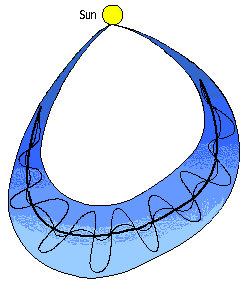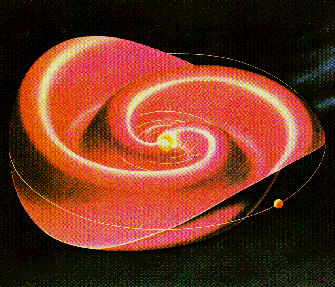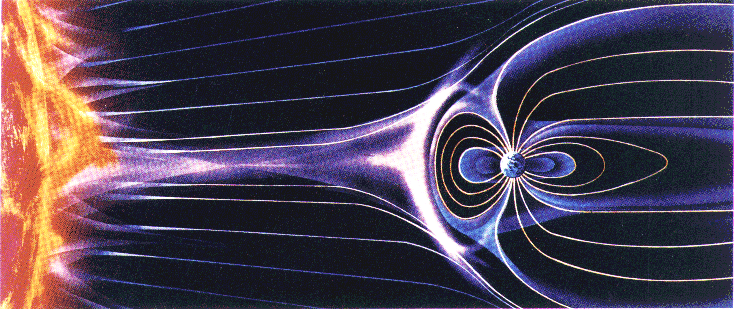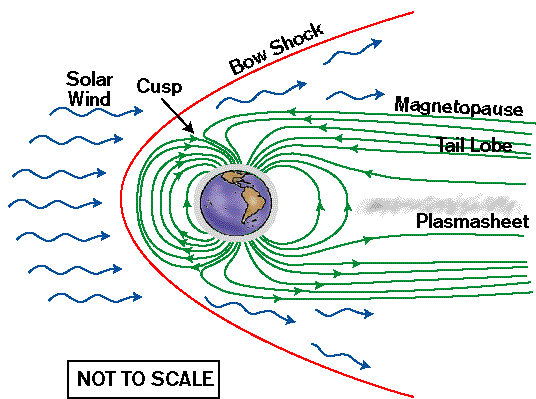MFI Team Science
Introduction
The MFI team's science endeavors are shared between those areas in which our members take the lead, which are listed below, and those in which we collaborate with science teams all around the world. The collaborations are many, mainly because of the obvious importance of the WIND magnetic field data in many supporting roles. The MFI bibliography (listed at the bottom) is split almost evenly according to those two areas, the team's lead science and support science. Presently there are seven lead science areas listed generally according to three broad categories of study: (1) solar wind, (2) magnetosphere and its boundaries, and (3) the lunar wake. In turn, the broadest category, the solar wind, can be thought of as split into studies of large-scale features (e.g., magnetic cloud structure, heliospheric current sheet (HCS) geometry, and interplanetary shock geometry, and the relationship of these to the Sun) and small-scale features (boundaries of these same objects and their other small-scale features, as well as MHD discontinuity structure, etc.). Further, large-scale solar wind events are studied according to whether they are quasi-periodic events (e.g., HCS and corotating streams) or transient events (e.g., ejecta from CME's and magnetic clouds, etc.); an interplanetary shock could be either, but usually shocks are transient events.
Areas
 Magnetic Clouds
Magnetic Clouds
Large transient structures ( ~ 1/4 AU) emanating from the Sun and observed in the solar wind and interacting with it. They are characterized by an enhanced magnetic field intensity, large and smooth magnetic field rotation throughout, and a depressed proton temperature, compared to the ambient plasma. Often a shock wave precedes the magnetic cloud and is driven by it. Magnetic clouds usually cause geomagnetic storms at Earth and the upstream interplanetary shock causes a sudden commencement. The MFI team is studying every aspect of magnetic clouds, including their intrinsic properties, their solar origin, and their interaction with Earth's magnetosphere and its bow shock. A list of times when magnetic clouds are observed by WIND is available.

Heliospheric Current Sheet
The very large-scale sheet of electrical current that separates the Sun's magnetic field lines, that are frozen into the solar wind, according to the field's polarity, i.e., toward or away from the Sun. The field regions on either side of this current sheet are referred to as interplanetary sectors, and the number of these change in time. The MFI team studies the large and sometimes small-scale structure of these HCS's, the relationship of the HCS to the Sun, and a so-called plasma sheet that is observed to be associated with it. A list of WIND HCS crossing times is available.
Interplanetary Shocks
Impulsive MHD discontinuities in the solar wind across which the entropy increases (i.e., causes an increase of disorder in the plasma). These are caused by solar ejecta or magnetic clouds ramming into the solar wind ahead of it or by the overtaking of a slow by a fast solar wind stream. The MFI team is interested in the origin of interplanetary shocks, their intrinsic properties, and how they interact with the Earth. A list of interplanetary shock encounter times is provided.
Discovery of the Double Discontinuity
This is a newly identified MHD structure which consists of an intimate combination of an interplanetary slow shock wave and a rotational discontinuity of usually large discontinuity-angle. First discovered in the solar wind and magnetic field data of the WIND spacecraft (by Prof. Y. C. Whang, Catholic University of America, on the MFI team), these discontinuities have also been observed recently in the magnetotail from other spacecraft observations by the same team.

Bow Shock
The shock wave observed just upstream of the Earth's magnetosphere caused by the supersonic and super-Alfvenic solar wind ramming into the Earth's magnetosphere. (SuperAlfvenic refers to when the solar wind's speed exceeds a characteristic speed that depends on the solar wind's density and the interplanetary magnetic field strength.) The MFI team provides a list of all WIND bow shock crossings for use by other scientists, as well as participates in the study of bow shock characteristics under various circumstances.

Magnetosphere
The overall magnetic environment around the Earth developed by the interaction of the solar wind flowing past the Earth's intrinsic magnetic field. It is sometimes referred to as an elongated cavity in the solar wind caused by this interaction. The magnetic field inside is formed by the sum of the Earth's intrinsic field and those fields from various other sources, including electrical currents on the boundary (called the magnetopause). The downstream side of the magnetosphere is called the magnetotail. The MFI team's interests are mainly in the magnetosphere during geomagnetically active periods and in its boundaries.
Lunar Wake
The wake behind the Moon caused by the solar wind interacting with it. The WIND spacecraft has passed through this wake numerous times providing some occasions for its intensive study. This interaction excludes the existence of an upstream bow shock, because the solar wind directly impacts the Moon, an electrically insulating body. The MFI team examines many properties of the wake, including comparisons of its cause to other types of solar wind interactions.
Cooperative Science: Space Weather Prediction